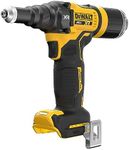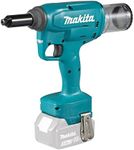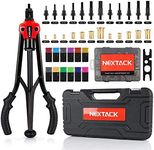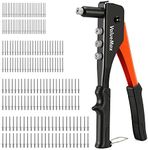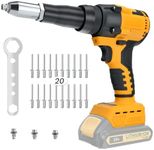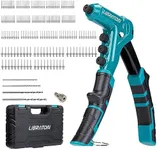Buying Guide for the Best Rivet Guns
Choosing the right rivet gun can make your fastening tasks much easier and more efficient. Rivet guns are used to join materials together by driving rivets through them, and they come in various types and sizes. The best rivet gun for you depends on the kind of projects you plan to tackle, the materials you'll be working with, and how often you expect to use the tool. Understanding the key specifications will help you select a rivet gun that matches your needs and ensures reliable, comfortable operation.Type (Manual, Pneumatic, Electric)The type of rivet gun refers to how the tool is powered. Manual rivet guns require hand strength to operate and are best for occasional or light-duty use. Pneumatic rivet guns use compressed air, making them suitable for frequent or heavy-duty tasks, as they reduce hand fatigue and speed up the process. Electric rivet guns are powered by batteries or electricity and offer a balance between convenience and power, ideal for users who want more ease than manual tools but don't have access to an air compressor. To choose the right type, consider how often you'll use the tool and the volume of work you expect—manual for small, infrequent jobs, pneumatic for high-volume or industrial use, and electric for regular but moderate tasks.
Rivet Size CompatibilityRivet size compatibility indicates the range of rivet diameters and lengths the gun can handle. Some rivet guns are designed for small, standard sizes, while others can accommodate larger or specialty rivets. This is important because using the wrong size can lead to poor fastening or tool damage. When choosing, check the typical rivet sizes required for your projects—if you work with thin materials, a gun for smaller rivets is sufficient, but for thicker or tougher materials, ensure the gun supports larger rivets.
Material and Build QualityThe material and build quality of a rivet gun affect its durability and comfort. Tools made from high-quality metals like steel or aluminum tend to last longer and withstand more demanding use, while plastic components may be lighter but less durable. A well-built rivet gun also feels comfortable in hand and reduces fatigue during extended use. If you plan to use the tool frequently or on tough materials, prioritize sturdy construction; for occasional, light tasks, a lighter build may be sufficient.
Nosepiece OptionsNosepieces are the parts of the rivet gun that hold and set the rivet, and different sizes are needed for different rivet diameters. Some rivet guns come with interchangeable nosepieces, allowing you to switch between sizes easily. This flexibility is important if you expect to use a variety of rivet sizes. If your work is specialized and only uses one size, a fixed nosepiece may be fine, but for general or varied use, look for a gun with multiple nosepiece options.
Ergonomics and Ease of UseErgonomics refers to how comfortable and easy the rivet gun is to use. Features like cushioned grips, balanced weight, and smooth trigger action can make a big difference, especially during long projects. A tool that is easy to handle reduces strain and increases accuracy. If you have larger projects or expect to use the tool for extended periods, prioritize ergonomic features; for quick, occasional jobs, basic comfort may be enough.

